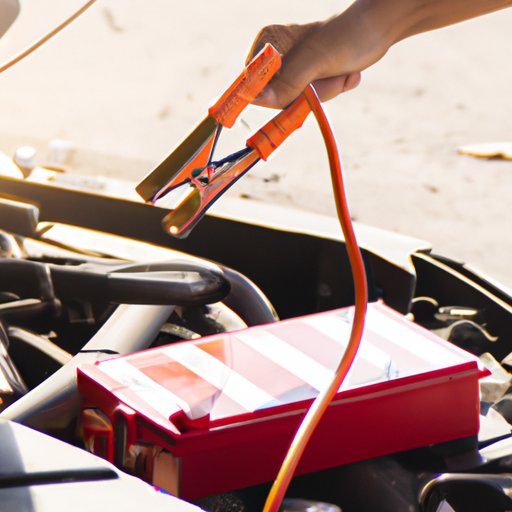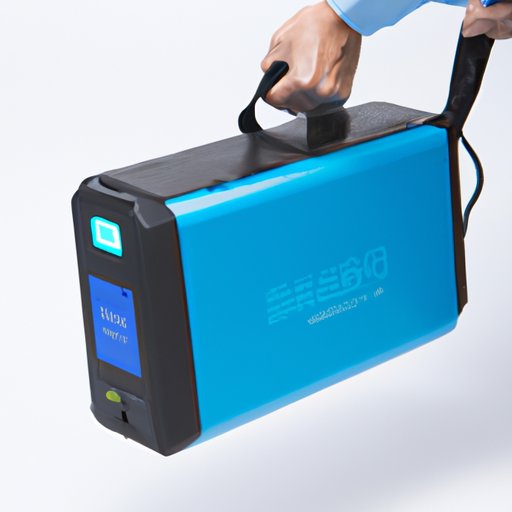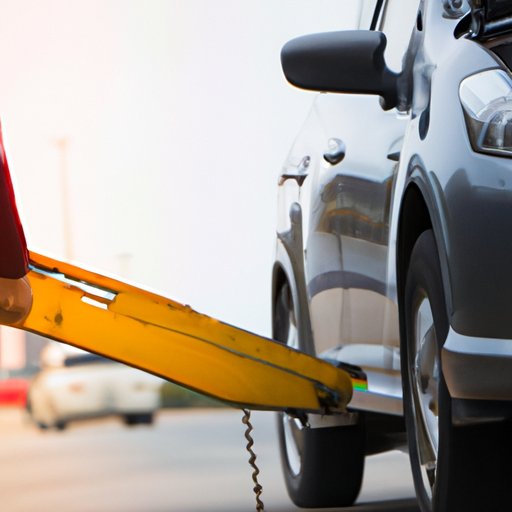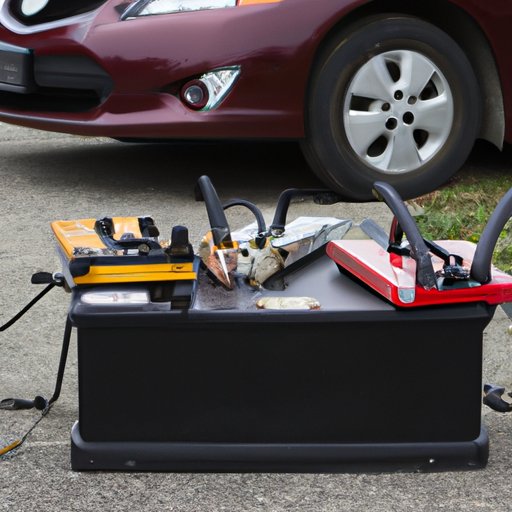Introduction
Starting an automatic car with a dead battery can be a challenging task, but it is important to know how in case you find yourself in this situation. In this article, we will discuss what a dead battery is, why knowing how to start an automatic car with a dead battery is important, and provide step-by-step instructions on how to do so.
A dead battery is one that is unable to hold a charge and is no longer able to power the car. This can happen due to a number of reasons including age, corrosion, discharging too much, or lack of maintenance. Knowing how to start an automatic car with a dead battery is important as it could potentially save you time and money.

Jump Start the Battery with Another Car
One way to start an automatic car with a dead battery is by using another car’s battery to jump start it. This is done by connecting the two batteries together via jumper cables. It is important to take safety precautions when doing this as the process involves working with electricity.
Safety Precautions
Before attempting to jump start the car, make sure both cars are turned off and the keys are removed from the ignition. Check that both batteries have enough electrolyte fluid and that they are not corroded. Make sure all electrical accessories such as headlights, radios, and air conditioning are turned off.
It is important to note that the jumper cables should never be connected directly to the car battery. The negative terminal should be connected to an unpainted metal surface away from the battery. Also, make sure that the clamps are securely placed on the battery terminals and that the jumper cables are not twisted or damaged.
Step-by-Step Instructions
Once you have taken the necessary safety precautions, you can begin the process of jump starting the car. Make sure the cars are parked close together and the jumper cables are ready. Begin by connecting one end of the positive cable (red) to the positive terminal of the dead battery, then connect the other end of the positive cable to the positive terminal of the good battery. Next, connect one end of the negative cable (black) to the negative terminal of the good battery, then connect the other end of the negative cable to an unpainted metal surface away from the dead battery.
Start the car with the good battery first, then start the car with the dead battery. Let the cars run for a few minutes, then remove the jumper cables in reverse order. Disconnect the negative cable from the unpainted metal surface, then disconnect the negative cable from the good battery. Finally, disconnect the positive cable from the dead battery, then disconnect the positive cable from the good battery.
Use an External Battery Charger
Another way to start an automatic car with a dead battery is by using an external battery charger. This device is used to charge the dead battery and get the car running again. It is important to take safety precautions when using an external battery charger.
What is an External Battery Charger?
An external battery charger is a device that is used to charge a dead battery. It works by connecting the charger to the battery terminals and providing an electrical current that charges the battery. The charger monitors the charging process and shuts off automatically when the battery is fully charged.
Safety Precautions
Before using an external battery charger, make sure the car is turned off and the keys are removed from the ignition. Check that the battery has enough electrolyte fluid and that it is not corroded. Make sure all electrical accessories such as headlights, radios, and air conditioning are turned off.
Step-by-Step Instructions
Once you have taken the necessary safety precautions, you can begin the process of charging the dead battery. Connect the charger to the battery terminals and follow the manufacturer’s instructions for charging. Once the battery is fully charged, disconnect the charger and start the car. If the car does not start, check the connections and try again.
Replace the Dead Battery
If the jump start and external battery charger methods do not work, you may need to replace the dead battery. This is a more involved process and requires some mechanical knowledge.
What is Involved in Replacing a Battery?
Replacing a battery involves removing the old battery and installing a new one. This process involves disconnecting the negative and positive terminals, removing the old battery, cleaning the battery tray and terminals, installing the new battery, and connecting the negative and positive terminals.
Safety Precautions
Before attempting to replace the battery, make sure the car is turned off and the keys are removed from the ignition. Make sure all electrical accessories such as headlights, radios, and air conditioning are turned off. Wear protective gloves and eyewear when working with the battery.
Step-by-Step Instructions
Once you have taken the necessary safety precautions, you can begin the process of replacing the battery. Begin by disconnecting the negative terminal of the battery, then disconnect the positive terminal. Remove the old battery and clean the battery tray and terminals. Install the new battery, making sure it is securely fastened in place. Reconnect the positive terminal, then reconnect the negative terminal.
Once the new battery is installed, start the car and let it run for a few minutes. Make sure the battery is charging properly and the car is running smoothly. If there are any issues, consult a mechanic.
Push Start the Vehicle
If the car still will not start after replacing the battery, you may need to push start the vehicle. This method involves having someone else push the car while you attempt to start the engine.
What is Involved in Push Starting a Vehicle?
Push starting a vehicle involves having someone else push the car while you attempt to start the engine. This method requires two people and can be dangerous if not done correctly.
Safety Precautions
Before attempting to push start the vehicle, make sure the car is turned off and the keys are removed from the ignition. Make sure all electrical accessories such as headlights, radios, and air conditioning are turned off. Wear protective gloves and eyewear when pushing the car.
Step-by-Step Instructions
Once you have taken the necessary safety precautions, you can begin the process of push starting the vehicle. Have one person get into the car and put their foot on the brake pedal. Have the other person push the car until it reaches a certain speed (usually between 10 and 20 mph). When the car is moving at the desired speed, have the driver shift the gear into neutral and press the accelerator. The car should start at this point.
Once the car is started, let it run for a few minutes before turning it off. Make sure the battery is charging properly and the car is running smoothly. If there are any issues, consult a mechanic.

Use a Portable Power Pack
If the car still will not start, you may need to use a portable power pack. This device is designed to provide a quick boost of power to get the car running again.
What is a Portable Power Pack?
A portable power pack is a device that is designed to provide a quick boost of power to get the car running again. It works by connecting the power pack to the battery terminals and providing an electrical current that starts the car. The power pack is easy to use and can be stored in the trunk of the car for emergency situations.
Safety Precautions
Before using a portable power pack, make sure the car is turned off and the keys are removed from the ignition. Make sure all electrical accessories such as headlights, radios, and air conditioning are turned off. Make sure the power pack is fully charged and in good working condition.
Step-by-Step Instructions
Once you have taken the necessary safety precautions, you can begin the process of using the power pack. Connect the power pack to the battery terminals and follow the manufacturer’s instructions for starting the car. Once the car is started, let it run for a few minutes before turning it off. Make sure the battery is charging properly and the car is running smoothly. If there are any issues, consult a mechanic.

Tow the Vehicle to a Mechanic
If all else fails, you may need to tow the vehicle to a mechanic. This is the last resort and should only be done if the car is unable to be started.
What is Involved in Towing a Vehicle?
Towing a vehicle involves having a tow truck come and pick up the car and take it to a mechanic. This process requires a tow truck and can be expensive.
Safety Precautions
Before attempting to tow the vehicle, make sure the car is turned off and the keys are removed from the ignition. Make sure all electrical accessories such as headlights, radios, and air conditioning are turned off. Wear protective gloves and eyewear when dealing with the tow truck.
Step-by-Step Instructions
Once you have taken the necessary safety precautions, you can begin the process of towing the vehicle. Call a tow truck and explain the situation. Request that the tow truck come and pick up the car and take it to a mechanic. Once the car is at the mechanic, they will diagnose the problem and provide a solution.
Use Jumper Cables and Booster Packs
Another way to start an automatic car with a dead battery is by using jumper cables and booster packs. This method is similar to the jump start method but requires additional equipment. It is important to take safety precautions when using jumper cables and booster packs.
What are Jumper Cables and Booster Packs?
Jumper cables and booster packs are devices that are used to provide a quick boost of power to get the car running again. The booster pack works by connecting the jumper cables to the battery terminals and providing an electrical current that starts the car. The booster pack is easy to use and can be stored in the trunk of the car for emergency situations.
Safety Precautions
Before using jumper cables and booster packs, make sure the car is turned off and the keys are removed from the ignition. Make sure all electrical accessories such as headlights, radios, and air conditioning are turned off. Make sure the booster pack is fully charged and in good working condition.
Step-by-Step Instructions
Once you have taken the necessary safety precautions, you can begin the process of using the jumper cables and booster pack. Connect the booster pack to the battery terminals and follow the manufacturer’s instructions for starting the car. Once the car is started, let it run for a few minutes before turning it off. Make sure the battery is charging properly and the car is running smoothly. If there are any issues, consult a mechanic.
Conclusion
Starting an automatic car with a dead battery can be a challenging task, but it is important to know how in case you find yourself in this situation. In this article, we discussed what a dead battery is, why knowing how to start an automatic car with a dead battery is important, and provided step-by-step instructions on how to do so. We also discussed safety precautions that should be taken when attempting to start the car.
The methods discussed in this article include jump starting the battery with another car, using an external battery charger, replacing the dead battery, push starting the vehicle, using a portable power pack, towing the vehicle to a mechanic, and using jumper cables and booster packs. Each method requires different tools and knowledge, so it is important to choose the right method for your situation.
(Note: Is this article not meeting your expectations? Do you have knowledge or insights to share? Unlock new opportunities and expand your reach by joining our authors team. Click Registration to join us and share your expertise with our readers.)
